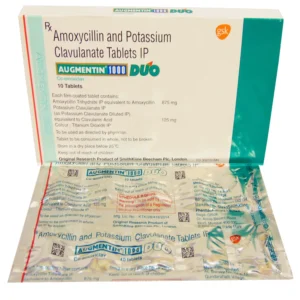What is Claribid 500 mg?
Claribid 500 mg is a prescription antibiotic used to treat a wide range of bacterial infections. It contains Clarithromycin, a macrolide antibiotic known for its effectiveness against respiratory, skin, and stomach infections. This higher-strength tablet is typically used when a stronger dose is needed to combat more severe or persistent bacterial infections. Clarithromycin, the active ingredient in Claribid 500 mg, is widely known in the United States under the brand name Biaxin.
How Claribid 500 mg Works
Clarithromycin, the active ingredient in Claribid, works by stopping bacteria from producing proteins they need to survive and multiply. Without these proteins, the bacteria can’t grow or spread, giving your immune system the upper hand to eliminate the infection.
It specifically targets bacteria without affecting viruses, which means it won’t work on conditions like the common cold or flu.
Manufacturer Information
Claribid 500 mg is produced by Abbott Healthcare Pvt. Ltd., a globally recognized pharmaceutical company known for its strict quality standards and innovative healthcare products.
Medical Uses of Claribid 500 mg
Claribid 500 mg is widely prescribed for:
Respiratory Tract Infections
Including bronchitis, pneumonia, pharyngitis, and tonsillitis. It helps relieve symptoms quickly and effectively clears the underlying bacterial cause.
Skin and Soft Tissue Infections
Used for infections like cellulitis or infected wounds that need a stronger antibiotic.
Ear Infections
Effective against bacteria causing middle ear infections or otitis media, especially in adults.
Helicobacter pylori Eradication
Often used in combination with other medications to eliminate H. pylori, a common cause of stomach ulcers.
Claribid 500 mg Dosage Information
Recommended Dosage for Adults
The typical dose is 500 mg twice daily for 7 to 14 days, depending on the infection’s severity.
Dosage Adjustments
If you have kidney or liver disease, your doctor may prescribe a lower or less frequent dose.
Important: Never self-prescribe or adjust your dose. Always follow your healthcare provider’s guidance.
How to Take Claribid 500 mg Correctly
-
Swallow the tablet whole with water.
-
You can take it with or without food (though food may help reduce stomach upset).
-
Take it at the same time every day to maintain even levels in your body.
-
Complete the full course, even if you feel better before it’s finished.
Skipping doses or stopping early can lead to the infection returning or becoming resistant.
Side Effects of Claribid 500 mg
Most people tolerate Claribid well, but side effects can still occur.
Common Side Effects
-
Nausea
-
Diarrhea
-
Abdominal discomfort
-
Headache
-
Metallic or bitter taste
Rare but Serious Side Effects
-
Liver dysfunction (yellowing of the skin or eyes)
-
Severe allergic reactions (swelling, rash, trouble breathing)
Contact your doctor immediately if you experience serious symptoms.
Warnings & Precautions
Before starting Claribid 500 mg, consider the following:
Allergic Reactions
Do not take Claribid if you’re allergic to clarithromycin, erythromycin, or other macrolides.
Liver or Kidney Disease
Your doctor may need to monitor you closely or adjust your dose.
Pregnancy & Breastfeeding
Only use if clearly necessary and prescribed. Clarithromycin may pose risks to the fetus or nursing infant.
Drug Interactions to Watch Out For
Claribid 500 mg can interact with other medications, such as:
-
Warfarin (blood thinner)
-
Statins (used to lower cholesterol)
-
Antiepileptics
-
Other antibiotics
Always share your current medication list with your healthcare provider to avoid dangerous interactions.
Storage and Handling Tips
-
Store at room temperature (below 30°C).
-
Keep away from sunlight and moisture.
-
Keep out of reach of children.
-
Do not use after the expiration date printed on the packaging.
User Reviews & Common Experiences
Many patients report rapid improvement in symptoms within 48 to 72 hours. Claribid is especially appreciated for its strong action against tough infections. While some users note a metallic taste or mild stomach upset, most find the drug very effective when taken as prescribed.
Claribid 250 mg vs Claribid 500 mg
The 250 mg version is typically prescribed for milder infections or in pediatric cases. Claribid 500 mg, on the other hand, is used for more severe infections or when higher blood levels of the antibiotic are needed for treatment.
Alternatives to Claribid 500 mg
If Claribid isn’t suitable for you, your doctor might consider:
-
Azithromycin
-
Erythromycin
-
Levofloxacin (a different antibiotic class)
Alternatives depend on your infection type, medical history, and drug tolerability.
Conclusion
Claribid 500 mg (Clarithromycin) is a powerful antibiotic trusted by doctors for treating various bacterial infections. It’s particularly effective in respiratory and skin-related cases and plays a key role in stomach ulcer treatment when combined with other drugs.
Like all antibiotics, it’s important to take it exactly as prescribed and complete the full course — even if you start feeling better early. And as always, speak to your doctor before beginning any new medication.
FAQs
Can Claribid 500 mg treat sinus infections?
Yes, it’s often prescribed for bacterial sinus infections due to its strong effect on respiratory bacteria.
Is Claribid 500 mg safe to take with food?
Yes, it can be taken with or without food. Taking it with food may help reduce stomach upset.
How long does it take for Claribid to work?
Most users feel improvement within 2–3 days, but it’s crucial to finish the entire course for complete recovery.
What happens if I miss a dose?
Take it as soon as you remember. If it’s almost time for your next dose, skip the missed one. Don’t double up.
Is Claribid 500 mg available over the counter?
No, it is a prescription-only medication and should be taken under medical supervision.











Reviews
There are no reviews yet.